To achieve success online, you need a robust search engine marketing strategy. This article walks you through the essentials of SEM, including key differences from SEO, strategies for ad creation, keyword optimization, and effective campaign structures.
Key Takeaways
- Search Engine Marketing (SEM) uses paid advertisements to improve website visibility, attracting targeted traffic and potential customers through a pay-per-click model.
- Key differences between SEM and SEO include SEM’s reliance on paid ads for quick visibility, while SEO focuses on organic growth through content optimization and longer-term strategies.
- Successful SEM requires effective keyword research, compelling ad copy, and landing page optimization, along with continuous monitoring and analysis to improve campaign performance.
What is Search Engine Marketing (SEM)?
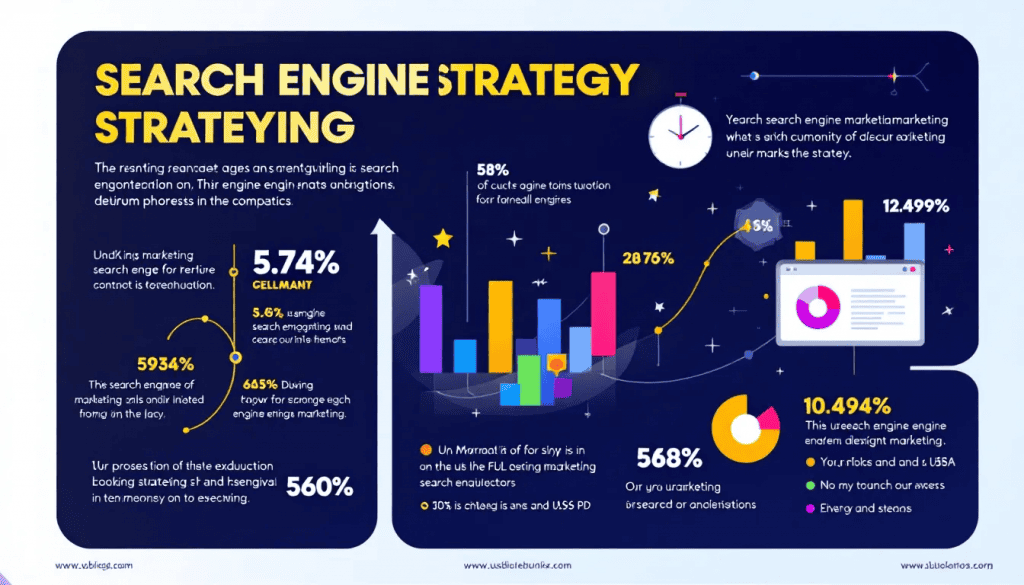
Search engine marketing (SEM) serves as an influential component in the realm of digital marketing. It enhances website prominence within search engine results through strategic use of paid search marketing and targeted advertising efforts. In contrast to search engine optimization (SEO), which aims at organic ranking growth, SEM utilizes platforms like Google Ads for positioning paid search advertisements prominently above organic listings on the result pages, thereby capturing the attention of prospective clients when they perform searches using relevant keywords.
Through a model where businesses bid on specific keywords and pay per user click, they are able to draw in desired traffic directly to their websites. This strategy significantly improves visibility while driving up both traffic flow and potential revenue gains.
The breadth of SEM encompasses different ad formats including textual ads, product listing ads, and shopping promotions designed specifically to engage users’ interest quickly enough so that they visit your site from these strategically placed ads within the search results spawned by certain targeted queries typed into a search engine.
SEM vs. SEO: Key Differences
SEM and SEO both enhance a website’s presence on search engine results pages, but they utilize distinct approaches. SEM leverages paid advertisements to vie for premier placements in search engine results through keyword bidding. The pay-per-click framework guarantees prompt exposure. It incurs expenses.
Conversely, SEO emphasizes elevating a site’s position within organic search results via the improvement of content and website architecture to ascend naturally in ranking. Unlike SEM’s swift visibility options for which you have to pay, SEO requires sustained commitment towards enhancing content quality, accruing backlinks, and honing technical aspects.
Grasping the capabilities and constraints of each method is crucial for businesses when deliberating how best to distribute their marketing investments efficiently.
How Search Engine Marketing Works
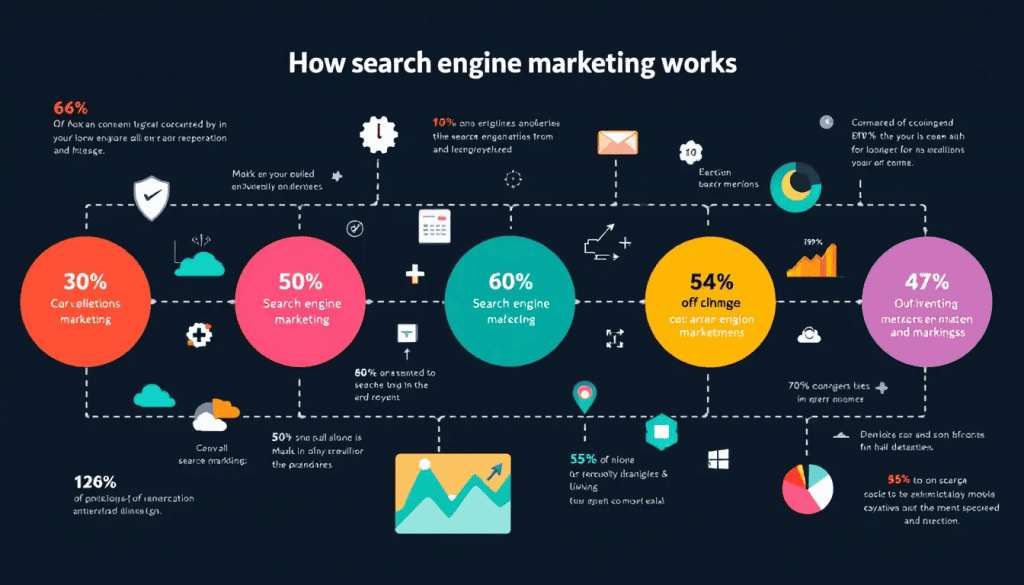
In the realm of search engine marketing and its broader category, search marketing, the emphasis is placed on selecting strategic keywords and participating in a bidding mechanism. Companies place bids on specific keywords that align with their offerings to achieve prominent placement on search engine results when users conduct searches for those specific terms.
The price paid per click (CPC) originates from an auction system where advertisers are charged each time someone clicks their advertisement. Keywords that many competitors want can often be more expensive. Hence conducting thorough keyword research is essential to manage budget constraints while still maximizing visibility. An ad’s position within the search engine results is influenced by both the bid amount and its Quality Score—a metric assessing relevance and overall performance of the ad.
The Ad Auction Process
The ads auction mechanism is fundamental to Search Engine Marketing (SEM), determining the visibility and ranking of advertisements on search engine results pages. As users initiate searches, this prompts an ad auction during which search engines scrutinize both bids and Quality Scores before deciding on the placement of ads. The latter score takes into account elements like the pertinence of an advertisement, its anticipated clickthrough rate, as well as user experience with the landing page. Notably, there are two main forms of auctions used: First-Price auctions require that winners pay exactly what they bid while Second-Price means paying marginally more than whatever amount was offered by the runner-up bidder. Ad outcome in these auctions is Influenced by contextual aspects such as a searcher’s location and their browsing history.
By choosing specific keywords associated with their offerings and determining maximum bids for them, advertisers enter into these competitive ad auctions aiming for high-value positions within search engine results. This environment favors those who engage in thoughtful bidding strategies complemented by quality advertising efforts—resulting in premier spots amid search outcomes—a methodology that strives to furnish users with ads closely aligned with their searched terms thereby improving their overall online searching journey.
Essential SEM Strategies for Success
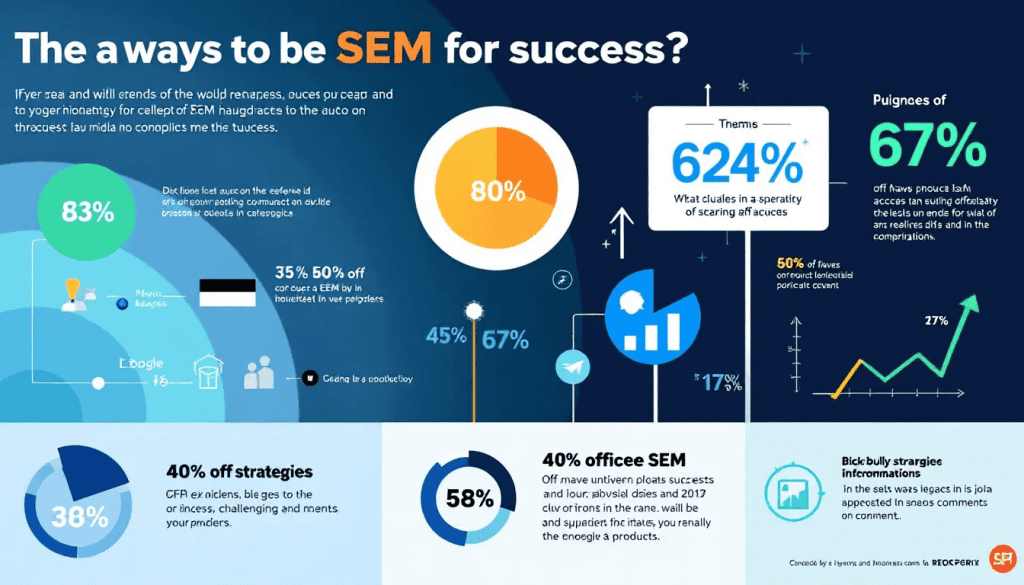
In the realm of search engine marketing, triumph hinges on a meticulous concoction of strategic foresight, extensive keyword research, and the crafting of persuasive advertisements. SEM strategies that are executed with finesse not only enhance website visibility but also draw in customers poised to complete a transaction.
Exploring this domain Reveals pivotal components including the creation of compelling ad copy that leverages both urgency and special offers, along with fine-tuning keywords to resonate with users’ search intent. When businesses master these tactics, they can surpass their rivals and optimize their returns from investments made into SEM initiatives.
Crafting Compelling Ad Copy
Mastering the creation of effective ads copy is essential for the success of SEM initiatives. Captivating your audience from the outset is critical, and a robust headline that tackles users’ issues head-on can seize their attention quickly. Using Dynamic Keyword Insertion (DKI) adds relevance to your advertisement by integrating terms used in user searches, thus improving engagement levels. Attractive descriptions spotlighting exclusive promotions and advantages entice users Increasing the likelihood they will engage with your ad.
Fostering trust through displays of social proof like authenticated critiques and supplementary advertising materials bolsters both dependability and conversion rates. Employ A/B testing to explore diverse iterations of your ad copy – this helps pinpoint which versions strike a chord with your intended demographic most effectively. The outcome is an optimization cycle that promotes higher click-throughs and enhanced conversions by utilizing superior performing ads.
The essence of devising powerful ad copy lies not only in creativity, but also in comprehending – then strategically responding to – prospective customers’ needs and desires.
Leveraging Urgency and Offers
Incorporating elements like countdowns, exclusive deals, and limited-time offers in your advertisements can effectively create a compelling sense of urgency. This approach harnesses the fear of missing out (FOMO) to persuade hesitant buyers into making prompt purchase decisions, thereby boosting conversion rates by motivating them to act quickly and take advantage of the special offers available.
Optimizing Keywords for Search Intent
Ensuring your ads are displayed to the appropriate audience necessitates aligning keywords with users’ search intentions. Conducting keyword research is instrumental in uncovering phrases that prospective clients might use while looking for products or services similar to what you offer. When these target keywords correspond with user’s searching purposes—be it for information, navigation, or transactions—the relevance and potency of your advertising efforts increase significantly. Target high commercial intent keywords judiciously as they signal a searcher’s readiness to purchase, enhancing the likelihood of conversion.
To refine targeting and budgetary effectiveness, incorporating negative keywords can reduce extraneous traffic that doesn’t contribute to your objectives. Prioritize terms boasting substantial search volume coupled with minimal competition. This strategy enhances your prospects of ascending through the ranks within search results pages (SERPs). This meticulous cultivation of keyword optimization underpins cost-effective Search Engine Marketing (SEM) campaigns honed for precision targeting.
Structuring Your SEM Campaigns
It is crucial to have a well-organized structure for your SEM campaigns if you want to optimize their success. Having such a structured approach improves the control over keywords, ads, and budget allocation. This leads to creating ads that are more pertinent and accurately targeted.
In this section, we delve into why an efficient campaign framework matters and discuss how ads groups contribute significantly in elevating the performance of campaigns.
Effective Campaign Structures
Various advertising objectives and demographic groups are best served by specific types of campaigns, ranging from raising brand recognition to eliciting a direct reaction. Enhancing your Google experience. Ads account structure can lead to better management and the creation of more precise ad copy, which in turn boosts the Quality Score and reduces cost-per-click.
It is vital for an SEM campaign’s efficiency and efficacy that it be organized properly.
Importance of Ad Groups
Ad groups serve as an essential element in SEM campaigns, allowing advertisers to neatly categorize their keywords and ads into orderly clusters. By assembling related keywords together, advertisers can craft ads that closely align with user queries, thus improving Quality Scores, the efficiency of the ads themselves, and ultimately ad rank.
Employing this focused strategy guarantees that every single ad group is tailored towards distinct segments of the audience, thereby boosting the efficacy of the overall campaign.
Enhancing Landing Page Experience
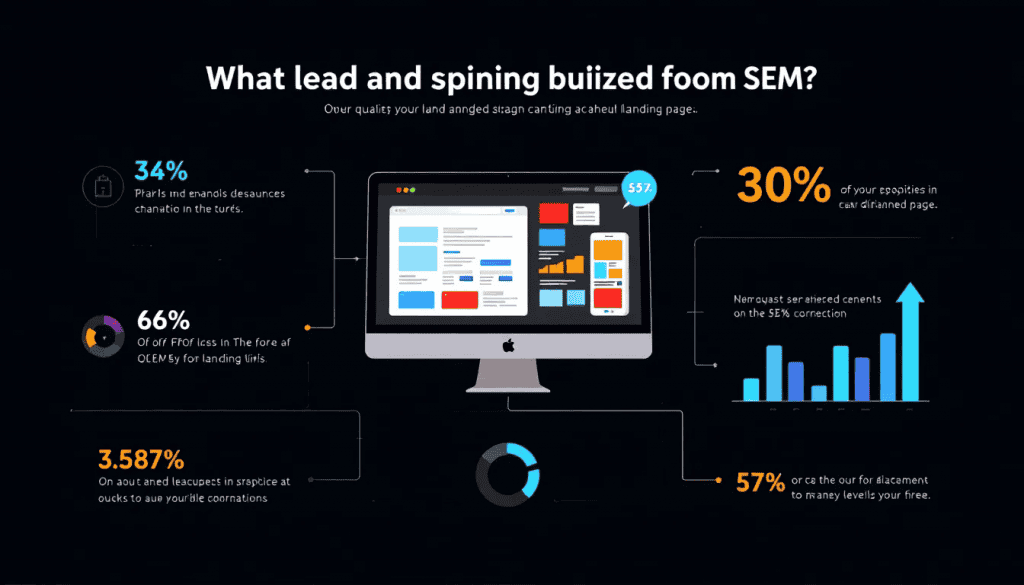
Ensuring a flawless experience on landing pages is vital for turning visitors into buyers. Important aspects of an effective landing page are uniform messaging, easy-to-understand navigation, and quick load times.
It’s crucial to match the content on your landing pages with what users anticipate and optimize them for mobile use in order to significantly improve Quality Scores as well as conversion rates. To secure elevated conversion ratios and better user engagement, fine-tuning your landing pages is indispensable.
Conversion Rate Optimization
Grasping the desires and requirements of your target audience is essential when designing landing pages that successfully lead to conversions. Incorporating elements of trust like client endorsements and safety seals can boost authenticity, prompting users to respond positively. It’s vital to engage in ongoing experimentation and refinement with various aspects of your landing page such as titles, visuals, and prompts for action to heighten conversion percentages.
Facilitate a straightforward path for user conversion by including clear clickable links within advertisements and consider offering deals as an incentive to enhance interest levels which could result in increased purchases. By adopting this vigilant stance towards upgrading your landing pages regularly, you ensure they remain highly effective tools that elevate conversion rates while optimizing the benefits from your Search Engine Marketing (SEM) ventures.
Monitoring and Analyzing SEM Performance
It is essential to consistently observe and evaluate the performance of Search Engine Marketing (SEM) in order to make necessary modifications promptly and refine campaign strategies. Through an analysis of SEM metrics, companies can identify successful tactics as well as areas that require enhancements, enabling them to base their advertising optimization decisions on solid data.
The focus here will be on identifying crucial metrics worth tracking along with discussing the various tools at one’s disposal for conducting analytics within the realm of SEM.
Key Metrics to Track
It is critical to monitor important metrics like click-through rate (CTR), cost per click (CPC), and impressions in order to enhance the effectiveness of Search Engine Marketing (SEM). The CTR reveals how well an advertisement grabs the attention of its audience, CPC gives insight into how economically resources are being utilized for each ad click, and impressions indicate the extent and exposure level that advertisements achieve, offering a sense of their total influence.
Keeping a close watch on these indicators allows advertisers to verify that their campaigns align with set goals and affords valuable knowledge required for making informed modifications.
Tools for SEM Analytics
Leveraging analytics tools designed for SEM can significantly boost the effectiveness of campaigns by offering crucial data. Instruments such as ConversionIQ and WordStream’s Google Ads Performance Grader are pivotal in assessing PPC campaign metrics and pinpointing opportunities for enhancement.
Employing these resources allows marketers to execute comprehensive research and refine their search engine marketing strategies, leading to improved outcomes.
Utilizing Social Media for SEM
Platforms like Facebook, Instagram, Twitter, LinkedIn, and Pinterest can serve as valuable supplements to your SEM strategy. By sharing content on these networks, interacting with followers, and getting involved in pertinent conversations can bolster a brand’s marketing endeavors and stimulate the creation of paid social advertisements.
The segment that follows explores the integration of social media into an SEM strategy and delineates the advantages that this amalgamation can yield.
Choosing the Right Platforms
It’s essential to pinpoint the social media platforms where your target audience spends their time for effective channel selection. LinkedIn and Twitter typically offer greater efficacy in B2B marketing contexts, whereas YouTube ads can be leveraged for wide-reaching brand awareness campaigns.
By selecting the appropriate platforms, you guarantee that your Search Engine Marketing (SEM) strategies are not only well-focused but also yield significant impact.
Improving Your Quality Score
Quality Score serves as a gauge for assessing the caliber of your advertisements, keywords, and landing pages, rating them on a scale from 1 to 10. This score is affected by elements like ad relevance, anticipated clickthrough rate (CTR), and the user experience on landing pages. By elevating these components, you can boost the effectiveness of your ads while lowering expenses and securing superior positions in search results.
The following segment outlines tactics for augmenting your Quality Score with an aim to improve SEM performance overall.
Best Tools for SEM
This section presents an array of tools designed to improve SEM campaigns, highlighting their distinct capabilities and advantages. Herein, we explore several top-notch instruments for SEM that are equipped with essential features aimed at boosting campaign effectiveness.
Google Ads Keyword Planner
The Google Ads Keyword Planner is a complimentary resource instrumental in uncovering fresh keywords and overseeing budgets for pay-per-click campaigns. It offers projected bid figures and has the capability to produce as many as 750 long-tail keywords per search inquiry, which proves essential for comprehensive keyword research, planning of Google AdWords campaigns, and meticulous budget management.
Employing this tool facilitates pinpointing pertinent keywords while also monitoring search trends to refine Search Engine Marketing (SEM) strategies effectively.
Semrush
Semrush serves as a robust instrument for crafting SEM strategies and conducting competitive intelligence. It pinpoints rivals, examines PPC keywords, and delivers crucial indicators like CPC, search volume, and data on competition. By scrutinizing the marketing tactics of competitors and their regional internet footprint using Semrush, one can enhance ad campaigns and elevate the effectiveness of SEM initiatives.
Why SEM is Crucial for Business Growth
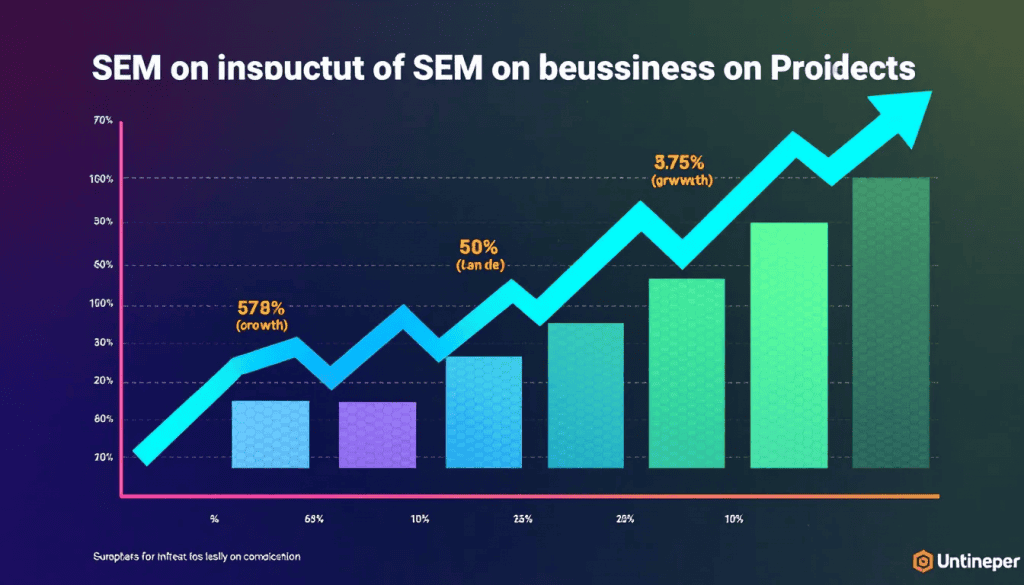
In the current digital era, the role of search engine marketing (SEM) in fostering business development is critical. It serves to enhance visibility on search engine results pages when natural rankings are insufficient, thus enabling enterprises to efficiently connect with their intended demographic and propel expansion. By executing effective SEM strategies, businesses can witness increased conversion rates and a boost in revenue by directing ads at prospective buyers who are poised to make purchases.
SEM campaigns typically outperform traditional marketing techniques regarding click-through rates as well as conversion metrics, offering an economical solution for companies looking to broaden their market presence. In essence, through lead generation improvements and boosted brand recognition alongside encouraging local consumers to engage with brick-and-mortar stores – Search Engine Marketing can substantially aid in elevating business growth.
Summary
To excel in search engine marketing, one must grasp the delicate interplay between organic and paid tactics, enhance ad copy as well as keyword optimization, organize campaigns efficiently, and perpetually assess their effectiveness. Utilizing resources such as Google Ads Keyword Planner and Semrush empowers companies to polish their SEM tactics for improved visibility, enhanced conversion rates, and notable expansion. Incorporating SEM into your digital marketing strategy is vital for maintaining competitiveness within the swiftly changing online arena. Bear in mind that each click presents a potential advantage. With adeptly crafted SEM strategies at play, these clicks can catalyze considerable triumphs for your business.
Frequently Asked Questions
What is the primary difference between SEM and SEO?
The primary difference between SEM and SEO is that SEM uses paid advertising for visibility, whereas SEO relies on organic strategies to enhance search rankings.
Understanding this distinction is crucial for effective digital marketing.
How does the ad auction process work in SEM?
The ad auction process in SEM determines ad placement and order based on a combination of bids and Quality Scores, assessing the relevance and performance of each ad.
This ensures that the most relevant ads receive priority in visibility.
Why is keyword research important in SEM?
Keyword research is essential in SEM because it uncovers the terms potential customers use, ensuring your ads are aligned with their search intent for maximum relevance and effectiveness.
What is a Quality Score, and why is it important?
Quality Score is a crucial metric that assesses the quality of your ads, keywords, and landing pages, directly impacting your ad performance, costs, and visibility in search results. A higher Quality Score leads to better ad placements and lower costs per click, making it vital for maximizing your advertising effectiveness.
How can social media complement SEM efforts?
Integrating social media with SEM can significantly enhance campaign performance by sharing valuable content and engaging audiences, leading to better ad inspiration and visibility.
This cohesive approach allows for a more comprehensive marketing strategy that maximizes reach and effectiveness.
